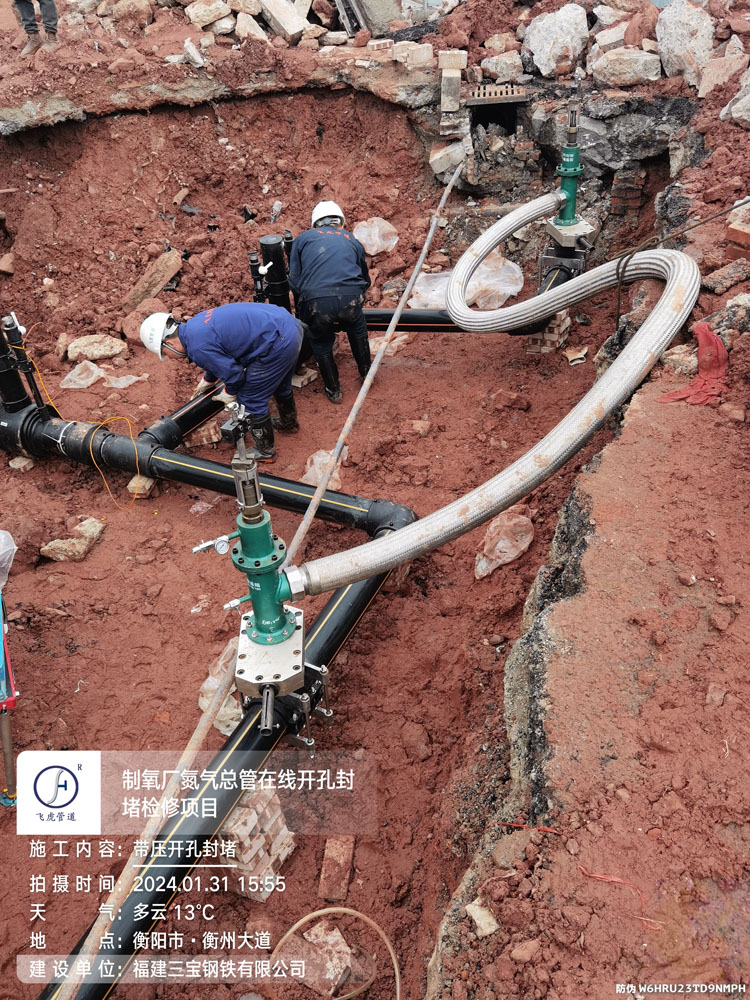
Understanding PE Line Stopping for HDPE Pipelines
PE Line Stopping Services for HDPE Pipelines are an essential solution for industries that need to maintain continuous flow while performing repairs, modifications, or maintenance. This method involves temporarily stopping the flow of liquids or gases in a pressurized HDPE pipeline without draining or shutting down the entire system. The process works by installing specialized equipment that isolates the section of the pipe where work is required, allowing teams to carry out necessary interventions. For HDPE pipelines, which are widely used in water, gas, and industrial networks due to their durability and flexibility, line stopping is a safe and efficient practice. Industries choose line stopping over traditional shutdowns because it prevents costly downtime and avoids disruptions to service. Specialized tools and technology, including stopple fittings and high-pressure plugs, are used to ensure precision. This method has become a trusted choice for modern infrastructure projects where continuity of service is critical.
Benefits of PE Line Stopping Services
One of the main benefits of PE Line Stopping Services for HDPE Pipelines is minimizing downtime during essential pipeline maintenance. Shutting down an entire pipeline system can be expensive and time-consuming, especially for industries that rely on constant flow to serve customers or keep operations running smoothly. By using line stopping, businesses save on operational costs and avoid lost productivity. Another benefit is safety, as the process reduces the risks associated with uncontrolled leaks or emergency shutdowns. It also allows operators to maintain uninterrupted service, ensuring critical utilities such as water supply and gas distribution remain functional. This approach also supports sustainability by lowering the risk of environmental contamination during interventions. Organizations across different sectors find that line stopping services not only protect infrastructure but also enhance long-term efficiency. Ultimately, these benefits make it an indispensable practice for pipeline operators who prioritize both safety and performance.
Common Applications in Various Industries
PE Line Stopping Services for HDPE Pipelines are widely applied across multiple industries that rely heavily on continuous operations. Municipal water utilities use line stopping to carry out pipe repairs, relocations, or upgrades without interrupting water distribution to communities. Industrial facilities, such as manufacturing plants, apply line stopping when equipment modifications or expansions are needed while maintaining production flow. Gas and energy providers benefit by performing maintenance and system upgrades without service interruptions, which is critical to safety and reliability. In mining and processing operations, line stopping allows adjustments to pipelines that transport water or chemicals essential to operations. Agricultural irrigation networks also use line stopping to keep systems functional during peak watering periods, avoiding delays that could impact crops. Each industry values this service for its ability to maintain service continuity while achieving technical upgrades. This broad application demonstrates its adaptability and importance in modern infrastructure management.
The Process of PE Line Stopping for HDPE Pipelines
The process of PE Line Stopping Services for HDPE Pipelines follows a systematic and professional approach to ensure safety and efficiency. It begins with a detailed assessment of the pipeline system, including material type, pressure rating, and flow requirements. After this, technicians prepare the site and install specialized fittings on the pipeline where the stop will be applied. These fittings are designed to work seamlessly with HDPE pipelines, preserving their structural integrity. Once the equipment is in place, the line stopping machine is deployed to insert the plugging mechanism into the pipeline, temporarily isolating the section for repair or modification. This is performed under live conditions, meaning the system does not need to be drained. After the work is completed, the stop is carefully removed, and the system is restored to normal flow. Each step is executed with precision to guarantee reliable performance and safety throughout the process.
Safety Considerations and Industry Standards
Safety is one of the most critical aspects of PE Line Stopping Services for HDPE Pipelines. Because the procedure involves live pipelines under pressure, strict safety standards must be followed at every stage. Industry guidelines, such as those provided by pipeline regulatory authorities, outline the necessary protocols to minimize risks. Professional service providers use only certified equipment designed to handle HDPE materials under varying pressures. Technicians are trained to identify potential risks such as pressure fluctuations, material weaknesses, or improper fittings. Adhering to international and local codes ensures that both workers and communities are protected during the procedure. Attempting line stopping without professional expertise can result in leaks, ruptures, or environmental hazards. This is why certified training and extensive experience are essential in executing the service safely. A strong safety culture not only prevents accidents but also enhances trust in the reliability of the pipeline system.
Choosing the Right PE Line Stopping Service Provider
Selecting the right provider for PE Line Stopping Services for HDPE Pipelines is vital to ensure reliable results. Experience is one of the most important factors, as providers with proven expertise in handling HDPE pipelines can better manage complex projects. Certifications and compliance with industry safety standards also indicate professionalism and technical competence. Advanced equipment and technology, specifically designed for HDPE pipelines, further guarantee precision and safety during the process. Providers should also offer flexibility, including the ability to handle emergency repairs and respond quickly to urgent situations. Customer support is another key consideration, as clients often seek ongoing maintenance partnerships beyond a single service. A reputable provider should demonstrate both technical capability and a commitment to long-term infrastructure reliability. Choosing wisely reduces risks, ensures cost efficiency, and guarantees smoother operations in critical projects.
Cost Factors and ROI of PE Line Stopping
The cost of PE Line Stopping Services for HDPE Pipelines varies depending on multiple factors, including pipeline size, system pressure, location, and the complexity of the required intervention. While upfront costs may seem significant, they are often far less than the financial impact of shutting down an entire pipeline. For industries where downtime equals lost revenue, line stopping provides a measurable return on investment. Preventive maintenance through line stopping also extends pipeline lifespan, reducing long-term replacement costs. Businesses that invest in this service benefit from improved efficiency and reduced risk of system failures. Moreover, by avoiding service disruptions, companies can maintain customer satisfaction and protect their reputation. Comparing expenses between full shutdowns and line stopping demonstrates how the latter is more economical in the long run. The savings gained in productivity and reduced risk make the investment worthwhile for any operation relying on HDPE pipelines.
Advancements in PE Line Stopping Technology
Technology continues to advance the capabilities of PE Line Stopping Services for HDPE Pipelines. Modern equipment is now designed for higher precision, making it easier to stop flow in pressurized systems with minimal disruption. Robotic systems and smart monitoring tools are being integrated to improve accuracy and safety during interventions. For HDPE pipelines, new sealing mechanisms and fittings have been developed to ensure compatibility and long-lasting performance. Digital tracking tools allow operators to monitor pressure and flow changes in real-time, reducing risks during the process. Eco-friendly innovations are also emerging, with equipment designed to minimize environmental impact by preventing leaks and reducing emissions. Looking ahead, the integration of AI and predictive maintenance tools will further enhance efficiency. These technological advancements are shaping the future of pipeline management, making line stopping services even more reliable and sustainable.
Real-World Scenarios Where PE Line Stopping Makes the Difference
In municipal water systems, PE Line Stopping Services for HDPE Pipelines make it possible to repair or relocate pipelines without disrupting the supply to thousands of residents. Industrial facilities benefit when system upgrades or expansions are completed while keeping production lines active. In the gas sector, safety demands that distribution not be compromised, making line stopping the preferred option for modifications. Agricultural networks can maintain irrigation during high-demand seasons by isolating sections of pipelines for repair without halting flow. Mining operations often use line stopping to adjust water and slurry pipelines while maintaining productivity. Each scenario highlights how the service prevents costly interruptions and ensures safety. The versatility of line stopping across different sectors proves its essential role in modern infrastructure management.
FAQ: PE Line Stopping Services for HDPE Pipelines
What makes PE line stopping different from pipeline shutdowns?
Line stopping isolates a section of the pipeline while keeping the rest operational, whereas shutdowns halt the entire system, causing downtime.
Can PE line stopping be applied to all sizes of HDPE pipelines?
Yes, with the right equipment, line stopping can be performed on a wide range of pipeline sizes and pressure ratings.
How long does a typical line stop procedure take?
The duration depends on pipeline size and project complexity, but many line stopping projects are completed within hours to minimize disruption.
Is line stopping safe for high-pressure HDPE pipelines?
Yes, when performed by certified technicians using specialized equipment, the process is safe even under high-pressure conditions.
How do I know if my project requires PE line stopping services?
If your operation cannot afford downtime but requires maintenance, repair, or modifications, line stopping is often the most effective solution.


